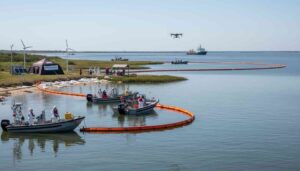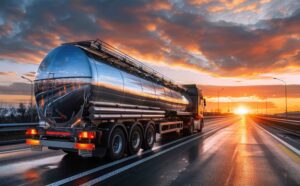Safety innovations in offshore oil and gas platforms have become a top priority as companies seek to mitigate risks associated with complex operations in harsh and remote environments. Technological advancements, regulatory changes, and the implementation of best practices have driven significant improvements in offshore safety. These innovations focus on preventing accidents, enhancing worker safety, and minimizing environmental impacts. Here are some of the key safety innovations transforming offshore oil and gas platforms:
1. Digital Twin Technology
- What It Is: A digital twin is a virtual model of a physical asset, such as an oil rig or platform, that mirrors real-time operations, conditions, and behaviors.
- Safety Benefits:
- Enables continuous monitoring of offshore platforms, allowing for predictive maintenance, early detection of potential failures, and remote troubleshooting.
- Reduces the need for human inspection in hazardous areas.
- Helps simulate and plan safety procedures for emergency scenarios, ensuring better preparedness.
Example: BP has used digital twins in their offshore platforms to monitor equipment performance and predict failures before they occur, thereby reducing unplanned downtime and accidents.
2. Robotics and Autonomous Systems
- What They Are: Robots and autonomous vehicles are increasingly being used for tasks that are dangerous for human workers.
- Safety Benefits:
- Drones and remotely operated vehicles (ROVs) can inspect underwater pipelines, perform structural integrity assessments, and even conduct repairs in dangerous environments, reducing the need for human divers.
- Autonomous surface vessels (ASVs) can patrol platforms, monitor safety zones, and detect potential hazards in the water.
- Robots equipped with cameras and sensors can navigate confined spaces, inspect equipment, and detect gas leaks, keeping workers out of high-risk areas.
Example: Equinor is developing autonomous robots to monitor offshore installations for leaks, corrosion, and other potential hazards.
3. Wearable Safety Technology
- What It Is: Smart wearables are equipped with sensors to monitor the health, location, and safety of workers.
- Safety Benefits:
- Smart helmets with augmented reality (AR) provide real-time data, work instructions, and hazard warnings to workers.
- Exoskeletons reduce the risk of injury from lifting heavy equipment and repetitive movements, improving ergonomics and reducing fatigue.
- Wearable sensors can track vital signs, detect fatigue, and alert workers if they are exposed to harmful gases or high-risk environments.
- Geofencing: Workers’ locations are monitored, and geofencing technology can alert them when they approach restricted or hazardous areas.
Example: Shell uses wearable technology to monitor workers’ health and safety conditions on offshore platforms, especially in extreme weather environments.
4. Advanced Fire and Explosion Prevention Systems
- What They Are: Fire and explosion prevention systems have become more sophisticated, focusing on both early detection and automatic suppression of fires.
- Safety Benefits:
- Inert gas injection systems automatically reduce the oxygen levels in spaces where flammable gases might accumulate, preventing explosions.
- Flame-retardant materials: Modern platforms are built with materials that are more resistant to fire and explosions, reducing the impact of incidents.
- Enhanced flame and gas detection sensors: These advanced sensors continuously monitor for combustible gases and immediately trigger alarms and safety protocols when they detect risks.
- High-pressure water mist systems are now used to rapidly cool and suppress flames in the event of a fire, offering faster response times than traditional fire suppression systems.
Example: TotalEnergies has integrated advanced gas detection systems and automatic fire suppression technologies across its offshore platforms to mitigate fire and explosion risks.
5. AI-Driven Predictive Maintenance
- What It Is: Artificial intelligence (AI) and machine learning algorithms analyze vast amounts of data to predict equipment failure and optimize maintenance schedules.
- Safety Benefits:
- Reduces the risk of mechanical failures by predicting when equipment is likely to malfunction, allowing repairs to be scheduled before a failure occurs.
- Decreases the frequency of emergency repairs, which are often dangerous.
- AI can detect subtle changes in equipment performance that human operators might miss, such as slight increases in temperature, pressure, or vibration that could signal potential issues.
Example: Chevron has implemented AI-driven predictive maintenance on offshore platforms, significantly reducing equipment failure rates and enhancing operational safety.
6. Enhanced Emergency Response and Evacuation Systems
- What It Is: Innovations in evacuation systems ensure that personnel can be safely and quickly evacuated in case of an emergency.
- Safety Benefits:
- Advanced lifeboats and life rafts with autonomous navigation systems allow for quicker and more efficient evacuations, even in rough seas.
- Escape chutes and slide-based evacuation systems provide fast, direct, and safe escape routes from elevated platforms.
- Emergency drones can deliver medical supplies and communicate with rescue teams in real-time, ensuring faster assistance in case of accidents or medical emergencies.
Example: Some offshore platforms in the North Sea are equipped with advanced life rafts and drones designed for emergency evacuation and remote assistance.
7. Real-Time Safety Monitoring and Big Data Analytics
- What It Is: Platforms are now fitted with an array of sensors collecting real-time data on equipment performance, environmental conditions, and worker safety.
- Safety Benefits:
- Big data analytics processes real-time information from various sensors to detect anomalies and identify potential risks before they escalate into serious incidents.
- Integrated safety management systems (SMS): These digital systems aggregate data from all safety systems (fire, gas, pressure, etc.) and provide centralized control and real-time risk assessment to safety managers.
- Platforms can now use predictive analytics to anticipate potential safety incidents by analyzing patterns in past data, allowing for preemptive action.
Example: Statoil (now Equinor) has been implementing real-time data analytics and digital safety management systems to enhance operational safety on its offshore platforms.
8. Virtual and Augmented Reality (VR/AR) for Safety Training
- What It Is: Virtual reality (VR) and augmented reality (AR) technologies are used to simulate real-world offshore platform conditions in a controlled environment for training.
- Safety Benefits:
- VR training simulations allow workers to experience realistic emergency scenarios, such as explosions, fires, and blowouts, without actual risk.
- AR-assisted maintenance provides real-time data, diagrams, and instructions while workers perform tasks, reducing the likelihood of human error.
- VR and AR can also be used for remote collaboration, allowing experts to guide offshore workers through complex tasks from onshore locations, reducing the number of personnel exposed to hazardous conditions.
Example: BP has adopted VR training programs that simulate emergency situations for offshore workers, improving their readiness for real-world scenarios.
9. Real-Time Remote Operations and Control
- What It Is: Remote operations enable platforms to be monitored and controlled from onshore facilities, reducing the need for personnel on-site.
- Safety Benefits:
- Remote-controlled systems: By automating key processes and enabling remote control, fewer personnel are exposed to hazardous conditions on the platform.
- Condition monitoring and troubleshooting can be performed remotely, minimizing the need for workers to access dangerous areas.
- Real-time data streams from platforms to onshore control rooms allow for quick responses to any safety-related incidents, often preventing accidents before they occur.
Example: Equinor’s Johan Sverdrup oil field in the North Sea is a key example of using real-time remote operations, significantly reducing on-site personnel and improving safety outcomes.
10. Advanced Personal Protective Equipment (PPE)
- What It Is: New materials and designs for personal protective equipment (PPE) provide enhanced protection for workers in extreme offshore environments.
- Safety Benefits:
- Flame-retardant and weather-resistant suits protect workers in environments prone to fire hazards or extreme cold.
- Smart helmets and visors with integrated cameras and sensors provide real-time situational awareness, allowing workers to avoid hazards more effectively.
- Integrated communications systems in PPE allow for constant communication between workers and control rooms, even in challenging environments.
Example: Some offshore platforms in the Gulf of Mexico have begun using advanced PPE, including smart helmets, to improve both communication and worker safety.
Innovations in safety technologies and practices are revolutionizing offshore oil and gas operations, reducing risks to both workers and the environment. By integrating digital systems, robotics, AI, advanced safety equipment, and enhanced emergency response systems, the industry is working toward safer, more reliable operations in some of the most challenging conditions. The continued advancement of these innovations will be essential for ensuring the long-term sustainability and safety of offshore oil and gas platforms.
Read more on Sparkview Energy:
Portable Gas Detectors: Ensuring Worker Safety in Hazardous Environments
Advancements in Oil and Gas Drilling Equipment: Efficiency and Safety Improvements
Sustainable Practices in the Upstream Oil and Gas Sector







